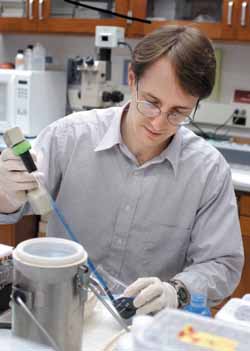
Brian Law, Ph.D. led the VUMC study. (photo by Dana Johnson)
VUMC research may slow tumor growth
New laboratory findings shed light on how the drug rapamycin, which is already approved for use as a transplant anti-rejection agent, may also turn out to be useful as an anti-cancer agent, say scientists in Vanderbilt’s department of Cancer Biology.
The researchers have discovered surprising details of the mechanism behind a potential cooperative effect between rapamycin and the naturally occurring cell growth inhibitor called TGF-beta that could, in effect, turn a cancer on itself.
Results of the studies, which appear in this month’s issue of Molecular and Cellular Biology, were led by Brian K. Law, Ph.D., research assistant professor in Cancer Biology, in affiliation with the laboratory of Dr. Harold L. Moses.
The current work grew out of pioneering studies by Moses, Benjamin F. Byrd Jr. Professor of Clinical Oncology, in the early 1990s showing that TGF-beta plays a role in suppressing cancers. The problem is that most cancers lose sensitivity to TGF-beta, said Law.
“The reason our study is interesting is because even though most cancers don’t respond to TGF-beta, they still have the receptors and signaling components that are required,” he said. “So the mystery is, why don’t these cancer cells respond?”
TGF-beta is a substance normally produced in the body and cancer cells should be exposed to its inhibitory effects, yet they grow unchecked. Even more baffling is the fact that cancer cells appear to actually secrete TGF-beta themselves. Once tumors start secreting TGF-beta, said Law, the substance takes on a different role.
“TGF-beta can inhibit the immune response and make cells more invasive, more metastatic,” he said. “The idea is that once the cells lose the growth inhibitory response, it’s actually a pro-tumor change. Our simplified model is that what rapamycin might do is take that TGF-beta that the tumor is secreting and turn it against the cancer.”
At the heart of this mystery is the role that TGF-beta plays in the chemical signaling that controls cell replication. TGF-beta inhibits the ability of cells to replicate themselves by activating two proteins, called p21 and p27, which in turn inhibit a key enzyme called Cdk2. When Cdk2 is hobbled, other signaling events required for DNA synthesis cannot occur and the cell is stopped in its tracks, unable to reproduce itself.
The researchers found that exposing cancer cells grown in the laboratory to a combination of rapamycin and TGF-beta increased the amounts of p21 and p27 that bind to and inhibit Cdk2, resulting in greater inhibition of cell growth than when cells were treated with TGF-beta alone. The addition of rapamycin, then, appears to restore and augment the tumor suppressive effects of TGF-beta.
The next step, said Law, is to develop a mouse model to test whether the drug combined with TGF-beta can inhibit cancer growth in animals. For these tests, the group will use one of the two derivatives of rapamycin that are currently in clinical trials for use as anti-tumor agents in humans.
Rapamycin is a natural substance isolated from the soil bacterium Streptomyces hygroscopicus. It was first used in humans as an anti-fungal drug, and was later shown to be effective as an immunosuppressant. All of these effects are related to its ability to inhibit cell proliferation. And even very primitive organisms, like yeast, are growth-arrested by rapamycin, so the response appears to be part of an ancient signaling pathway controlling cell proliferation.
The exact mechanism behind the response, however, seems to depend on cell type. The researchers found that in a breast cell line, for example, treatment with rapamycin and TGF-beta caused an increase in p27 binding and a decrease in p21 binding. But in the prostate cell line tested, binding of both p21 and p27 was stronger, and was correlated with a stronger inhibition of Cdk2 than was seen in the breast cells.
Delving beyond the reported results, the researchers are finding more intriguing clues as to how the mechanism works.
“We thought initially that (the response) might change the localization of p27,” said Law. “In other words, that it might move p27 into the nucleus where it binds and inhibits Cdk2. Actually, we got quite a surprise in that p27 localization doesn’t change, but when we treat with TGF-beta we get a lot of the Cdk2 moving out of the nucleus.
“What we’re working on now is fleshing out the rest of the story of how Cdk2 localization plays into this whole picture,” he continued. “The inhibition of Cdk2 we’ve seen in all the cells we’ve looked at, so that’s universal. But the mechanism…may be different in different cell types.”
TGF-beta is a multi-functional protein that plays a complex role in the body. When overproduced it can cause negative effects, such as pulmonary fibrosis and liver cirrhosis, so it would be harmful to treat a patient systemically with TGF-beta. Ideally, said Law, what they’d like is to design a drug that produces only the desirable effects of TGF-beta.
“In the near future when we figure out how TGF-beta actually does some of these things, we’ll be able to develop a drug that mimics its action,” he said. “And when we combine that with rapamycin, then I think we’ll have very potent anti-cancer effects.”
Other Vanderbilt researchers who contributed to the published results include Anna Chytil, Nancy Dumont, Elizabeth G. Hamilton, Mary E. Waltner-Law, Mary E. Aakre, and Cassondra Covington. The work was supported by grants from the U.S. Public Health Service and the National Cancer Institute.













